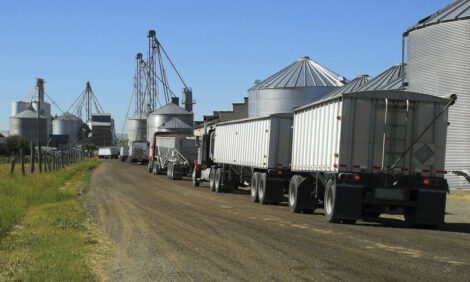K-State Swine Researchers Look for Options to DDGS
MANHATTAN, Kan. – Think that some pigs aren’t choosy about what they eat? Kansas State University researchers are finding that given the choice, swine prefer the taste of standard feed over grains that contain nutritionally-enhanced dried distiller grains with solubles, known simply as DDGS.
|
Need a Product or service?
|
|
DDGS is made by fermenting cereal grains, such as corn or sorghum. Distiller grains have higher fiber, fat, and crude protein than regular corn, though levels of these nutrients can vary by as much as 3 percent. The popularity of DDGS as swine feed has been varied because the quality of the product can change depending on what plants are used to make it.
K-State graduate student Chad Hastad said DDGS is one of two main by-products from the production of ethanol. Although many types of grain can be used to make ethanol, Hastad’s research has dealt mainly with corn ethanol and its byproducts.
Hastad, who has conducted many of the university’s recent trials on DDGS, said producers have been trying to use DDGS as a food source since the early 1950s. He said that early feeding attempts were not as successful because the amounts of nutrients in DDGS were not right for pigs.
“Now, though, there are better processing methods and more ethanol plants,“ Hastad said.
In one study last fall, Hastad said pigs were given the option of their regular feed or two different test feeds. The different feed was moved from trough to trough so pigs did not become accustomed to going to one trough for food they liked.
Over the course of the study, the amount of DDGS consumed by the pigs decreased.
“There is some palatability factor with feeding distiller’s grains that we haven’t identified yet,“ Hastad said. “We’re still trying to figure that out.“
One thing the K-State researchers do know is that there is a large variation in the amounts of minerals present in DDGS, including variations in levels of phosphorus and calcium. They’re planning more research to further understand why these variations happen. Hastad said that some variation in calcium levels could be from limestone that is added to DDGS at the processing plant. Limestone is used in some plants as a flow agent. Despite some inconsistencies, though, use of DDGS is on the rise.
“Distiller grain usage has increased greatly in the U.S. due to increased availability and increased cost of other dietary ingredients,“ said Mike Tokach, a K-State Research and Extension swine specialist.
“Our goal is to help producers use DDGS in the most economical manner possible.“
Source: Kansas State University - 21st April 2004


















